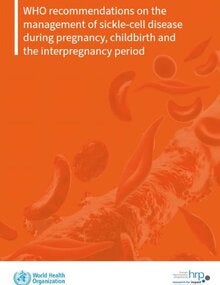Sickle-cell disease (SCD) is a group of autosomal recessive haemoglobin disorders that results from a gene mutation in the β-subunit of haemoglobin. It is a common inherited condition worldwide, affecting 7.74 million people. SCD is highly prevalent in sub-Saharan Africa, and causes a significant disease burden in other historically malaria-endemic regions of Africa, the Middle East, the Caribbean and South Asia. SCD also affects people in many other countries. Women who live with SCD are at higher risk for pregnancy complications. The guideline will be useful to those directly providing care to women during pregnancy and when giving birth, such as obstetricians, midwives, nurses and general practitioners. This guideline will also be useful to health-care providers responsible for developing national and local health-care protocols and policies, as well as managers of maternal and child health programmes, and policy-makers in all settings. Finally, the information in this guideline will be useful for developing clinical tools for pre- and in-service training of health workers and health-system strengthening efforts to enhance their delivery of clinical care. |

